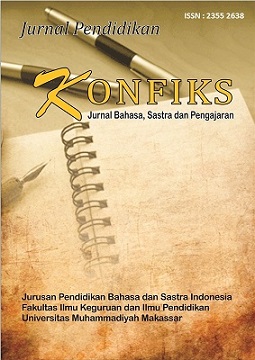MANTRA TETULUNGAN: STRUCTURE AND MEANING REVIEW
DOI: https://doi.org/10.26618/konfiks.v12i1.10372
structure, meaning, the Tetulungan mantra
Abstract
Mantra is a part of oral literature that is still commonly found in the lives of Indonesian people. The Tetulungan Mantra is one of the Javanese mantras that is still sustainable in the life of the people of the village of Cahaya Mas. This research was conducted to describe the structure and meaning of the Tetulungan mantra in the life of the Javanese people of Cahaya Mas village, Mesuji Makmur district. This research is a type of field research conducted using a qualitative descriptive method. The research data is in the form of quotations of words or sentences contained in the Tetulungan mantra. Mantras are obtained through an interview process conducted with elders who master the Tetulungan spell. After all the data is sufficient, then the analysis process is carried out using interactive techniques. The results of the research show that the Javanese mantra has the main function of rejecting various logs, calamities, calamities, and all the suffering that can come in human life. The spell has a unique structure compared to the structure of spells in general. Successively, the structure of the Tetulungan mantra includes opening, aim, suggestion, and closing elements. The mantra begins with the remembrance of Allah and ends with complete submission to Allah, the one who has power over all things. It also shows that the Tetulungan spell can only be recited by people who believe in Islam as their religion. In addition, the Tetulungan mantra also contains a very deep meaning regarding belief in God's power, submission to God, and the human perspective on God's creation.
References
Andalas, E. F. (2017). Dampak dan Fungsi Sosial Mitos Mbah Bajing Bagi Kehidupan Spiritual Masyarakat Dusun Kecopokan, Kabupaten Malang, Jawa Timur. Jurnal Puitika, 13 (1), 20- 31.
Anggoro, H. (2011). Struktur Mantra Primbon Ajimantrawara. Skripsi. Tidak Diterbitkan. Universitas Negeri Semarang.
Efriana, A., Missriani, M., & Fitriani, Y. (2021). Struktur, Makna, Fungsi, dan Nilai Budaya Dalam Mantra Aji Pemikat Di Desa Margotani Ii Kecamatan Madang Suku II Kabupaten OKU Timur. KREDO: Jurnal Ilmiah Bahasa dan Sastra, 5(1), 35-61.
Eliade, M. (1959). The Sacred and The Profane: The Nature of Religion. Harcourt, Brace.
Febriyanto, D., Rusminto, N. E., & Samhati, S. (2021). Mantra-Mantra Jawa: Kajian Makna, Fungsi, dan Proses Pewarisannya. Sosial Budaya, 18(2), 87- 96.
Hidayatullah, D. (2018). Struktur Mantra Kagancangan dalam Naskah Mantra Mistik. Undas, 14(2), 171-182.
Kasmilawati, I. & Effendi, R. (2012). Struktur Dan Fungsi Mantra Masyarakat Dayak Deah Desa Pangelak Kecamatan Upau Kabupaten Tabalong. Jurnal Bahasa Dan Sastra, 126-138.
Maknuna, L. L., Mustamar, S., & Ningsih, S. (2013). Mantra dalam Tradisi Pemanggil Hujan di Situbondo: Kajian Struktur, Formula, dan Fungsi. Publika Budaya, 1(1), 1-15.
Moleong., L. J. (2014). Metode Penelitian Kualitatif. Bandung: Remaja Rosdakarya.
Nasr, S. H. (1991). Knowledge and the Sacred. State University of New York Press.
Nurjamilah, A. I. (2015). Mantra Pengasihan: Telaah Struktur, Konteks Penuturan, Fungsi, dan Proses Pewarisannya. Riksa Bahasa, 1(2), 123-131.
Olang, Y., Astuti, S., & Jubang. (2020). Analisis Struktur dan Fungsi Mantra Dayak Suru’k Kecamatan Putussibau Selatan. Jurnal KANSASI, 5(2), 198-205.
Purwanti., & Wahyuni, I. (2020). Fungsi dan Nilai Mantra dalam Masyarakat Banjar. Calls, 6(2), 211-220.
Sari, N. I., Anshari., & Asri, A. (2021). Makna Mantra Kesaktian Boe pada Masyarakat Galesong Kabupaten Takalar. Indonesian Journal of Social and Educational Studies, 2(1), 85-97.
Sariasih, Yanti & Yulianto, Agus. (2019). Analysis of The Meaning of Mantra Ajian Jaran Goyang (Riffaterre Semiotic Study). Prosiding. Second Conference on Language, Literature, Education, and Culture (ICOLLITE 2018). Vol. 257 p.69-72.
Severi, C., & Tambiah, S. J. (2021). The Anthropology of Magic and Ritual Language. Cambridge University Press.
Sholikhah, U. N., & Mardikantoro, H. B. (2020). Satuan-Satuan Lingual dalam Tradisi Ngalungi di Desa Sekarsari Kecamatan Sumber Kabupaten Rembang. Jurnal Sastra Indonesia, 9(1), 28- 37.
Sugiyono. (2017). Metode Penelitian Pendidikan: Pendekatan Kuantitatif, Kualitatif, dan R&D. Bandung: Alfabeta.
Suharso., & Retnoningsih, A. (2020). Kamus Besar Bahasa Indonesia: Edisi Lux. Semarang: Widya Karya.
Tambiah, S. J. (1968). The Magical Power of Words. Man, New Series, 3(2).
Taum, Y. Y. (2011). Studi Sastra Lisan Sejarah, Teori, Metode, dan Pendekatan Disertai Contoh Penerapannya. Yogyakarta: Lamalera.
The Holy Qur’an, Surah Ali Imran (3): 191.
Triani, S. N., Yanti, L., & Kurniawan, K. (2019). Struktur, Fungsi, dan Makna Mantra Dayak Salako di Desa Bagak Sahwa Kecamatan Singkawang Timur. Cakrawala Linguista, 2(2), 89-94.
Wardani, A. P., Darmayanti, N., & Sofyan, A. N. (2021). Struktur Mantra dalam Buku “Jangjawokan Inventarisasi Puisi Mantra Sunda”: Kajian Etnolinguistik. Kajian Linguistik dan Sastra, 6(1), 54-71.
Wood, M. R. (2022). Oral Traditions and the Structure of Ritual Language in Southeast Asia. Journal of Folklore Research, 59(3), 234–251. https://doi.org/10.2979/jfolkrese.59.3.03
Downloads
Published
Issue
Section
License
Authors who publish with this journal agree to the following terms:
The author owns the copyright and grants the journal rights for first publication with the work simultaneously licensed under a Creative Commons Attribution License which allows others to share the work with acknowledgment of the work's authorship and initial publication in this journal.
Authors may enter into separate additional contractual agreements for the non-exclusive distribution of the published journal version of the work (for example, posting it to an institutional repository or publishing it in a book), with acknowledgment of its initial publication in this journal.
Authors are permitted and encouraged to post their work online (for example, in institutional repositories or on their websites) before and during the submission process, as this can lead to productive exchanges, as well as earlier and larger citations of published work (See The Effect of Open Access).
Statement of Authenticity and Manuscript Copyright can be downloaded: Here
After filling in the statement letter, please send via e-mail: konfiks@unismuh.ac.id





.png)


